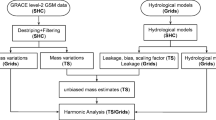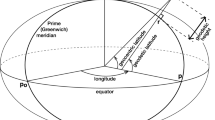Abstract
To understand and estimate wind speed differences across the coastal zone, two models, one theoretical and another semi-empirical, have been developed and verified by available data sets. Assuming that: (1) mean horizontal motion exists across the coastal zone; and (2) the geostrophic wind does not change appreciably at the top of the planetary boundary layer (PBL), the equation of motion in the direction of the wind can be reduced so that 341-01, where U, H, and C D are wind speed, height of PBL, and drag coefficient over the sea and land, respectively. For practice, C D SEA has been modified from a formula with U LAND as the only input. H SEA may be estimated routinely from known H D LAND LAND and the temperature difference between land and sea, which can be provided by such means as remote sensing from meteorological satellites. For a given coast, Cmay be estimated also. This formula is recommended for weather forecasters. The semiempirical formula is based mainly on the power law wind distribution with height in the PBL. The formula states that 341-02. Simultaneous offshore and onshore wind measurements made at stations ranging from Somalia, near the equator, to the Gulf of Alaska indicated that values of a and b are 2.98 and 0.34 with a correlation coefficient of -0.95. For oceanographic applications, a simplified equation, i.e., 341-03, is also proposed.
Similar content being viewed by others
References
Amorocho, J. and De Vries, J. J.: 1980, ‘A New Evaluation of the Wind Stress Coefficient over Water Surfaces’, J. Geophys. Res. 85, 433–442.
Blackadar, A. K.: 1960, ‘A Survey of Wind Characteristics below 1500ft’, Meteorol. Monogr. 4, 3–11.
Davenport, A. G.: 1965, ‘The Relationship of Wind Structure to Wind Loading’, National Physical Laboratory Symposium No. 16, Wind Effects on Buildings and Structures, pp. 54–102, Her Majesty's Stationery Office, London.
Fein, J. S. and Kuettner, J. P.: 1980, ‘Report on the Summer MONEX Field Phase’, Bull. Amer. Meteorol. Soc. 61, 461–474.
Hess, S. L.: 1959, Introduction to Theoretical Meteorology, Holt, Rinehart, and Winston, New York.
Holton, J. R.: 1979, An Introduction to Dynamic Meteorology, 2nd ed., Academic Press, New York.
Holzworth, G. C.: 1972, ‘Mixing Heights, Wind Speeds, and Potential for Urban Air Pollution throughout the Contiguous United States’, Office of Air Programs Pub. No. AP-101, Environmental Protection Agency, Research Triangle Park, North Carolina.
Hsu, S. A.: 1970, ‘Coastal Air-Circulation System: Observations and Empirical Model’, Mon. Weather Rev. 98, 487–509.
Hsu, S. A.: 1979a, ‘Mesoscale Nocturnal Jetlike Winds within the Planetary Boundary Layer over a Flat, Open Coast’, Boundary-Layer Meteorol. 17, 485–495.
Hsu, S. A.: 1979b, ‘An Operational Forecasting Model for the Variation of Mean Maximum Mixing Height across the Coastal Zone’, Boundary-Layer Meteorol. 16, 93–98.
Mahrt, L. and Lenschow, D. H.: 1976, ‘Growth Dynamics of the Convectively Mixed Layer’, J. Atmos. Sci. 33, 41–51.
Plate, E. J.: 1971, ‘Aerodynamic Characteristics of Atmospheric Boundary Layer’, available as TID-25465, National Technical Information Center, Springfield, Virginia.
Quayle, R. G.: 1980, ‘Climatic Comparisons of Estimated and Measured Winds from Ships’, J. Appl. Meteorol. 19, 142–156.
Sedefian, L.: 1980, ‘On the Vertical Extrapolation of Mean Wind Power Density’, J. Appl. Meteorol. 19, 488–493.
SethuRaman, S. and Raynor, G. S.: 1980, ‘Comparison of Mean Wind Speeds and Turbulence at a Coastal Site and Offshore Location’, J. Appl. Meteorol. 19, 15–21.
Yu, T. W.: 1970, ‘Diurnal Variation of Kinetic and Internal Energy in Onshore Winds along the Upper Texas Gulf Coast’, Rept. No. 19, Atmospheric Science Group, University of Texas, Austin.
Zimmerman, J. R. and Burton, W. D.: 1979, ‘Late Summer Gale Winds Offshore Coastal Oregon-Washington’, National Weather Digest 4, 27–40.
Author information
Authors and Affiliations
Rights and permissions
About this article
Cite this article
Hsu, S.A. Models for estimating offshore winds from onshore meteorological measurements. Boundary-Layer Meteorol 20, 341–351 (1981). https://doi.org/10.1007/BF00121378
Accepted:
Issue Date:
DOI: https://doi.org/10.1007/BF00121378




